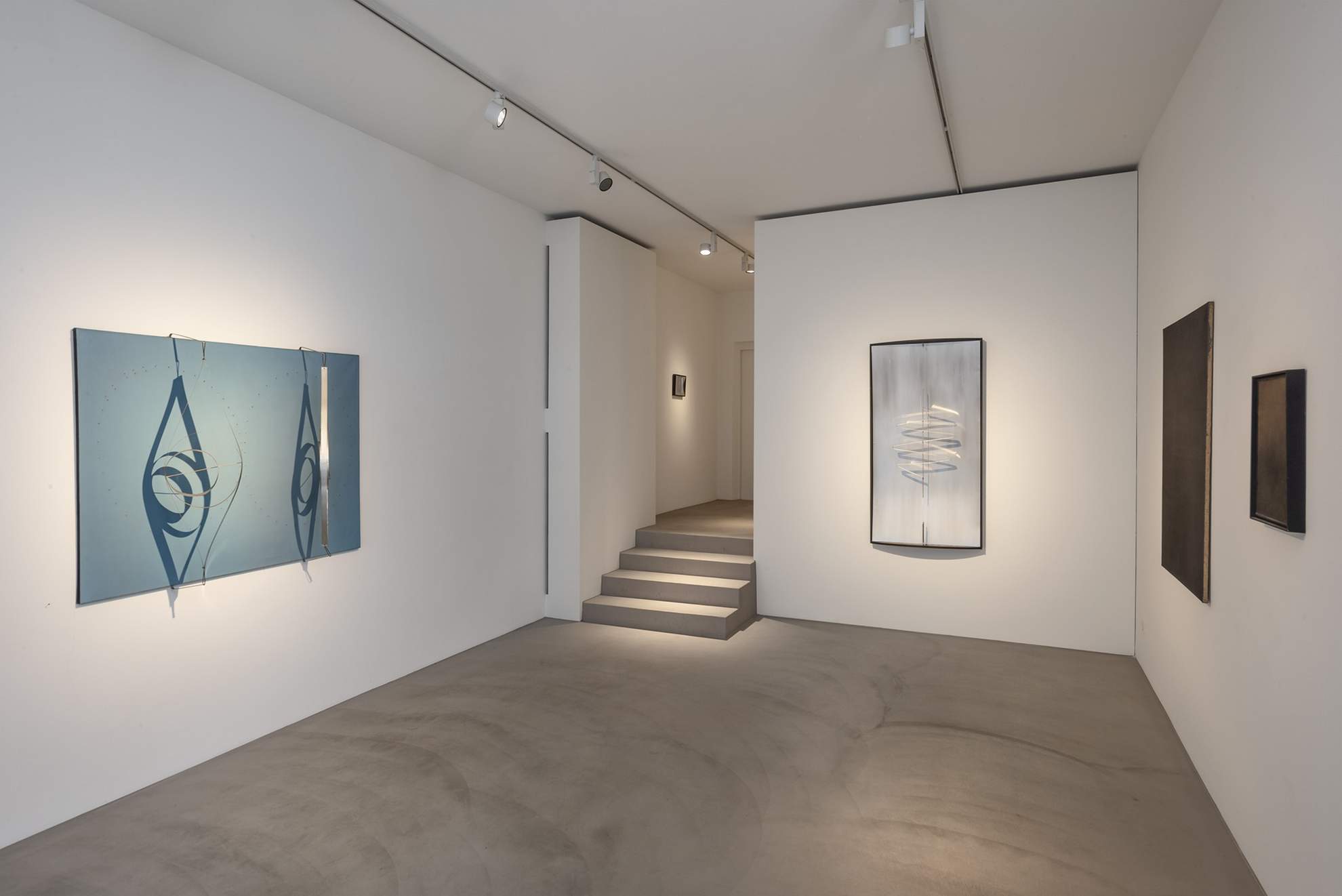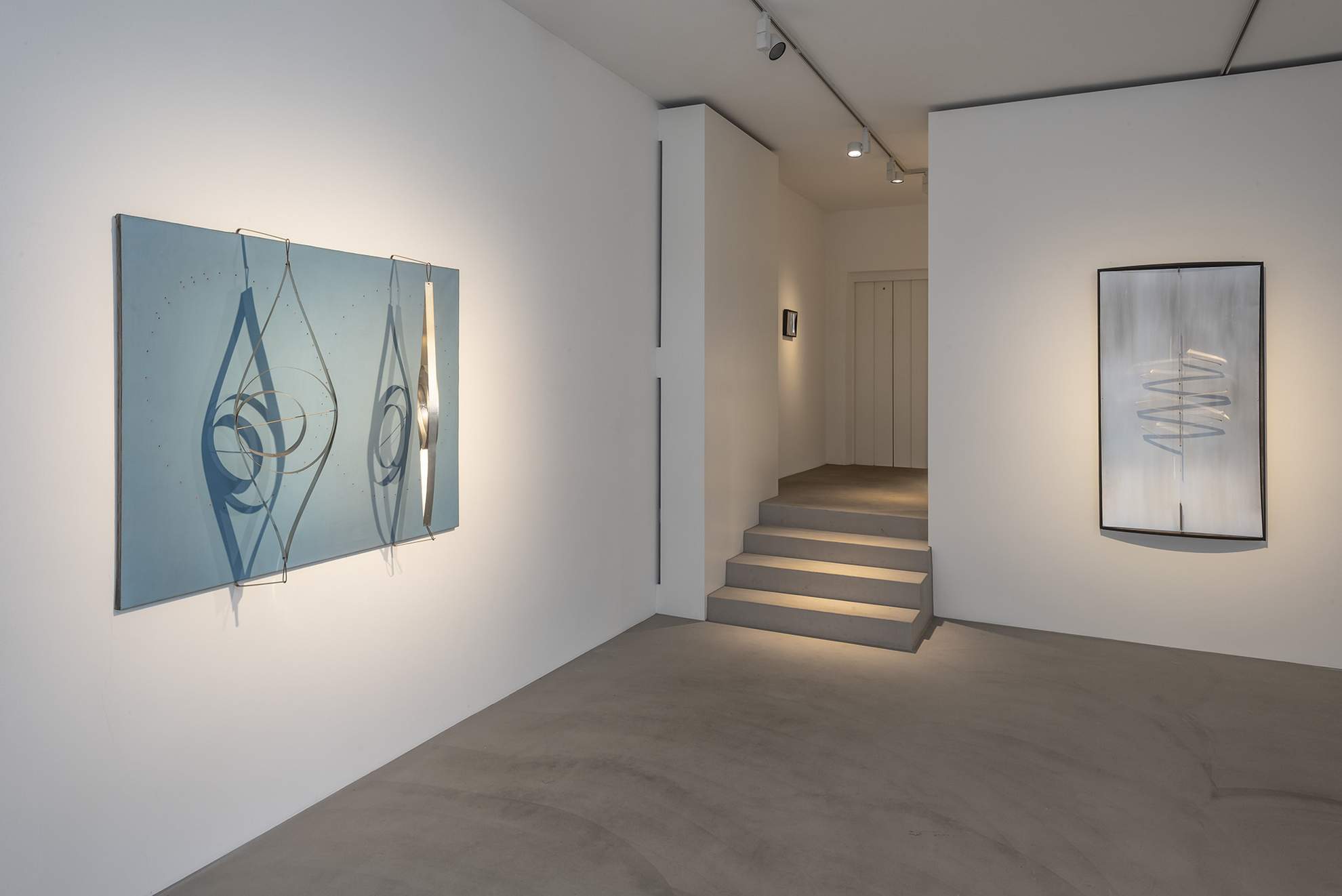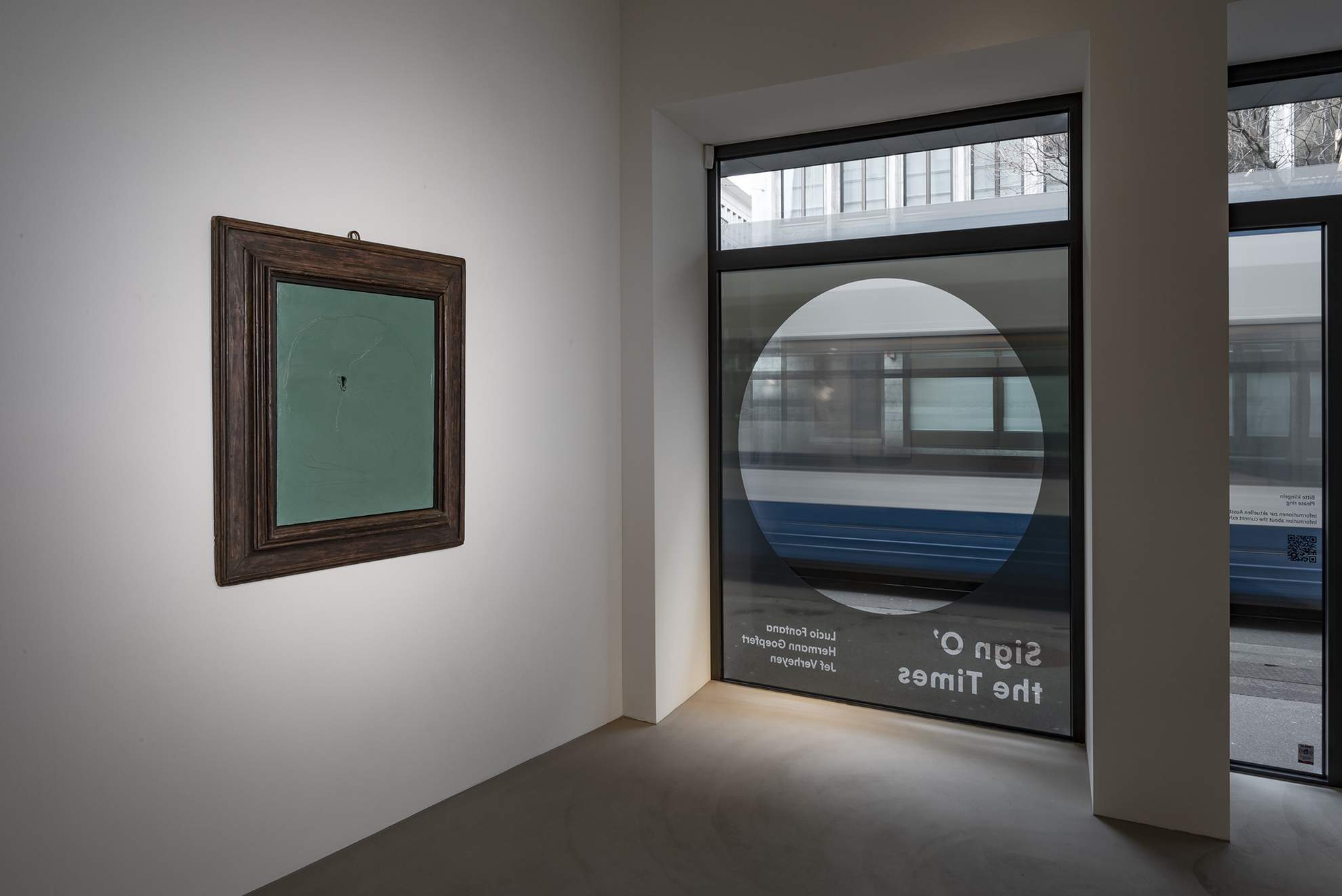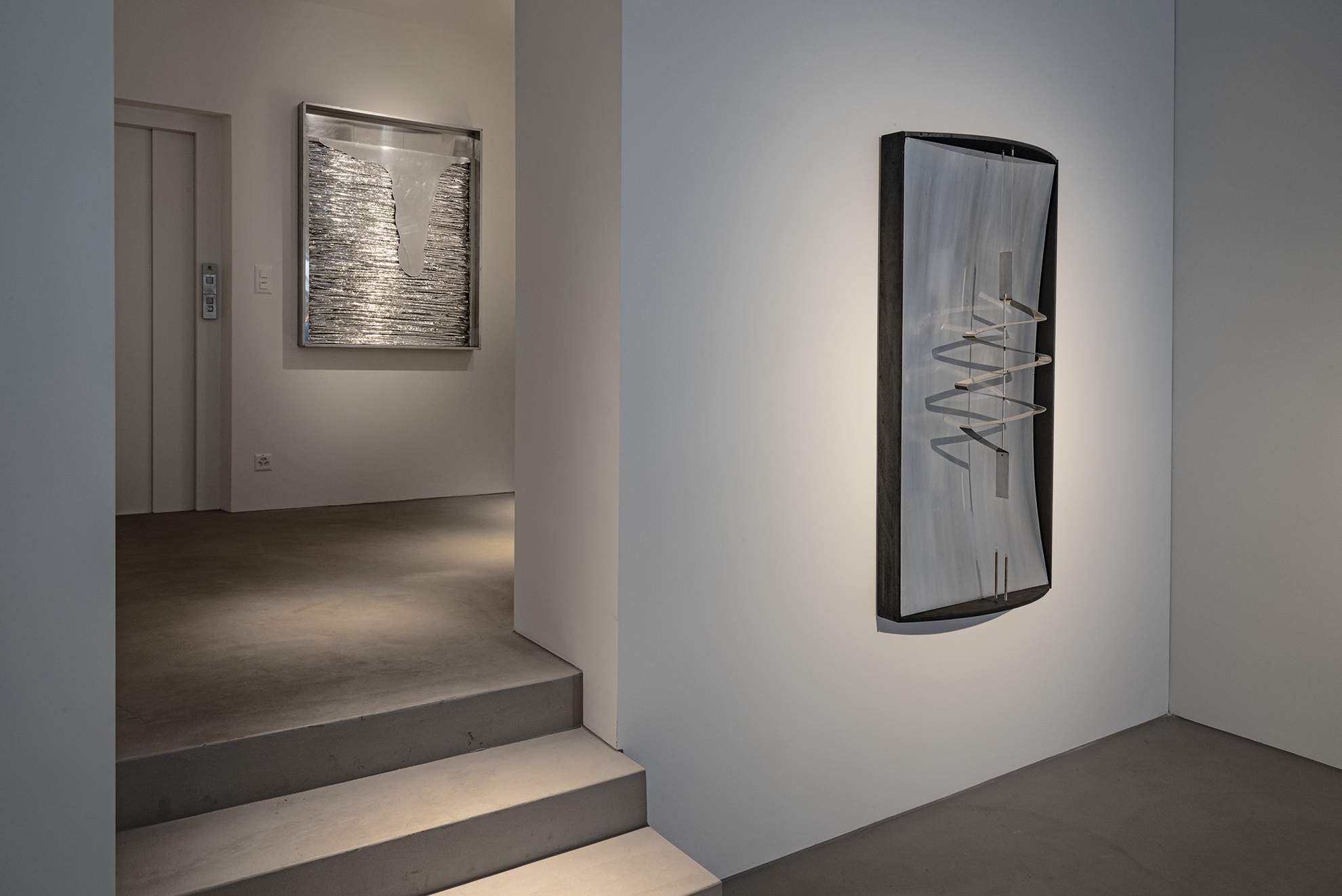
Sign O’ the Times
Lucio Fontana, Hermann Goepfert, Jef Verheyen
-
In the exhibition Sign O’ the Times, Galerie Dierking, on the Paradeplatz in Zurich, presents selected works by Lucio Fontana, Hermann Goepfert and Jef Verheyen, and explores the exceptional collaboration of the three ZERO artists.
During the 1960s, the ZERO movement made its mark right across Europe. Independently of one another, artists Lucio Fontana in Italy, Hermann Goepfert in Germany and Jef Verheyen in Belgium had begun to postulate monochrome as a new idea in painting, together with the use of real elements, particularly light and motion, as pictorial materials. United in the idea of superseding tradition and turning towards forward-looking utopias, the avant-gardists began to link up with one another and to hold joint exhibitions. The intensive artistic exchange between Goepfert, Fontana and Verheyen culminated in 1963, in a collaborative work they exhibited in Berlin.
The intensive artistic exchange between Goepfert,
Fontana and Verheyen culminated in 1963,
in a collaborative work they exhibited in Berlin.
From an art-historical view, this collaboration, "untitled" (1963) by Jef Verheyen, Lucio Fontana and Hermann Goepfert is undoubtedly one of the most important works of the post-war period, as one of the few collaborative works by several artists of different nationalities after 1945 – combining, moreover, significant aesthetic principles of eminent artists. The aesthetic principles, ideas and ideals integrated in the interaction of three ZERO artists reach their culmination in this work.
If Lucio Fontana had a catalysing function for the younger artists Jef Verheyen and Hermann Goepfert, he was at the same time receptive to the suggestions of the two. Verheyen visited Fontana for the first time in autumn 1957; more than 40 letters to Verheyen, dating from between 1959 and 1968, bear testimony to their friendship. At the beginning of the 1960s, Goepfert often accompanied Verheyen on visits to Fontana in his Milan studio. In 1965, Goepfert went in person to Milan to invite Fontana to a joint exhibition with himself and Jef Verheyen in Berlin (Galerie Christian Chruxin – situation 60) and Frankfurt-Niederursel (Galerie Dorothea Löhr). The Berlin exhibition showed the 1963 collaborative work, which had first been shown in that year in the Frankfurt Galerie d in the exhibition achrom 2.
Lucio Fontana (1899-1968)
Born in Argentina, Fontana finally settled in Milan. In his work he pursued the basic idea of a renewal of art by merging architecture, painting and sculpture. He was one of the most innovative 20th-century artists, always keen to experiment; he wished to transcend traditional painting, and his new "spatial'" art has remained strongly influential. His first perforated canvases date from 1949, and some ten years later Fontana began to pierce (usually monochrome) canvases, slashing them with a razor. His intention here was to unite real and imaginary space. In the work Concetto Spaziale (62 0 34) (1962), a hole in the upper quarter of the picture makes a mark on the rectangular blue canvas. While the work shown, with its vibrant colour, displays parallels with the collaborative work, the manner of execution evinces reduction and immediacy. The single perforation in the canvas concentrates Fontana's intention of penetrating the material of the self-contained form in order to render tangible the corporeality of the canvas. He transforms the plane surface into a relief, making it a spatial element in which a new, imaginary space can open up. In this sense, Concetto Spaziale (62 0 34) (1962) once more hallmarks the clear, forceful quality of Lucio Fontana's works.
Hermann Goepfert (1926-1982)
Working in Frankfurt am Main, Hermann Goepfert had begun in the 1950s to reduce the colour in his paintings, finally producing monochrome white grounds with tiny elevations in order to show real light as reflection. Subsequently, he replaced these sculptural structures with metal inserts and later also replaced the canvas with metal. His kinetic aluminium reflectors, such as DO III (1964), were designed to catch and reflect the ambient light. His primary focus was on the object hanging on coil springs in front of the background panel, set in motion by air currents to produce changing reflections. "Light is form": Goepfert's credo was intended to reveal the aesthetic quality of light by the use of pre-formed instruments – attempting above all to represent natural light. The Aluminium reflector DO III (1964) was exhibited the same year at the documenta. In the "Light and Motion“ section, with Heinz Mack, Otto Piene and Günther Uecker, Goepfert also exhibited his Optophonium. The artists dedicated their room to Lucio Fontana.
Jef Verheyen (1932-1984)
Belgian Jef Verheyen was one of the most eminent painters in the sphere of the ZERO group. After producing initially simple monochrome paintings in black and white, he turned to more complex variants using light and colour, for which he developed a technique using multiple, extremely thin layers of translucent glazes to create nuanced gradations of colour. The paintings shown here, dating from the early 1960s, illustrate his aspiration to represent solely the colours themselves. Here, too, Verheyen avoided any trace of brush-strokes, retreating as the artist into the background to allow space for the colours to unfold to full effect. Only on closer inspection do the colour gradients become apparent, endowing the colours with an almost immaterial effect. As the artist put it: "Seeing is feeling with the eyes".

Sign O’ the Times
Lucio Fontana, Hermann Goepfert, Jef Verheyen
-
The intensive artistic exchange between Goepfert,
Fontana and Verheyen culminated in 1963,
in a collaborative work they exhibited in Berlin.
In the exhibition Sign O’ the Times, Galerie Dierking, on the Paradeplatz in Zurich, presents selected works by Lucio Fontana, Hermann Goepfert and Jef Verheyen, and explores the exceptional collaboration of the three ZERO artists.
During the 1960s, the ZERO movement made its mark right across Europe. Independently of one another, artists Lucio Fontana in Italy, Hermann Goepfert in Germany and Jef Verheyen in Belgium had begun to postulate monochrome as a new idea in painting, together with the use of real elements, particularly light and motion, as pictorial materials. United in the idea of superseding tradition and turning towards forward-looking utopias, the avant-gardists began to link up with one another and to hold joint exhibitions. The intensive artistic exchange between Goepfert, Fontana and Verheyen culminated in 1963, in a collaborative work they exhibited in Berlin.
From an art-historical view, this collaboration, "untitled" (1963) by Jef Verheyen, Lucio Fontana and Hermann Goepfert is undoubtedly one of the most important works of the post-war period, as one of the few collaborative works by several artists of different nationalities after 1945 – combining, moreover, significant aesthetic principles of eminent artists. The aesthetic principles, ideas and ideals integrated in the interaction of three ZERO artists reach their culmination in this work.
If Lucio Fontana had a catalysing function for the younger artists Jef Verheyen and Hermann Goepfert, he was at the same time receptive to the suggestions of the two. Verheyen visited Fontana for the first time in autumn 1957; more than 40 letters to Verheyen, dating from between 1959 and 1968, bear testimony to their friendship. At the beginning of the 1960s, Goepfert often accompanied Verheyen on visits to Fontana in his Milan studio. In 1965, Goepfert went in person to Milan to invite Fontana to a joint exhibition with himself and Jef Verheyen in Berlin (Galerie Christian Chruxin – situation 60) and Frankfurt-Niederursel (Galerie Dorothea Löhr). The Berlin exhibition showed the 1963 collaborative work, which had first been shown in that year in the Frankfurt Galerie d in the exhibition achrom 2.
Lucio Fontana (1899-1968)
Born in Argentina, Fontana finally settled in Milan. In his work he pursued the basic idea of a renewal of art by merging architecture, painting and sculpture. He was one of the most innovative 20th-century artists, always keen to experiment; he wished to transcend traditional painting, and his new "spatial'" art has remained strongly influential. His first perforated canvases date from 1949, and some ten years later Fontana began to pierce (usually monochrome) canvases, slashing them with a razor. His intention here was to unite real and imaginary space. In the work Concetto Spaziale (62 0 34) (1962), a hole in the upper quarter of the picture makes a mark on the rectangular blue canvas. While the work shown, with its vibrant colour, displays parallels with the collaborative work, the manner of execution evinces reduction and immediacy. The single perforation in the canvas concentrates Fontana's intention of penetrating the material of the self-contained form in order to render tangible the corporeality of the canvas. He transforms the plane surface into a relief, making it a spatial element in which a new, imaginary space can open up. In this sense, Concetto Spaziale (62 0 34) (1962) once more hallmarks the clear, forceful quality of Lucio Fontana's works.
Hermann Goepfert (1926-1982)
Working in Frankfurt am Main, Hermann Goepfert had begun in the 1950s to reduce the colour in his paintings, finally producing monochrome white grounds with tiny elevations in order to show real light as reflection. Subsequently, he replaced these sculptural structures with metal inserts and later also replaced the canvas with metal. His kinetic aluminium reflectors, such as DO III (1964), were designed to catch and reflect the ambient light. His primary focus was on the object hanging on coil springs in front of the background panel, set in motion by air currents to produce changing reflections. "Light is form": Goepfert's credo was intended to reveal the aesthetic quality of light by the use of pre-formed instruments – attempting above all to represent natural light. The Aluminium reflector DO III (1964) was exhibited the same year at the documenta. In the "Light and Motion“ section, with Heinz Mack, Otto Piene and Günther Uecker, Goepfert also exhibited his Optophonium. The artists dedicated their room to Lucio Fontana.
Jef Verheyen (1932-1984)
Belgian Jef Verheyen was one of the most eminent painters in the sphere of the ZERO group. After producing initially simple monochrome paintings in black and white, he turned to more complex variants using light and colour, for which he developed a technique using multiple, extremely thin layers of translucent glazes to create nuanced gradations of colour. The paintings shown here, dating from the early 1960s, illustrate his aspiration to represent solely the colours themselves. Here, too, Verheyen avoided any trace of brush-strokes, retreating as the artist into the background to allow space for the colours to unfold to full effect. Only on closer inspection do the colour gradients become apparent, endowing the colours with an almost immaterial effect. As the artist put it: "Seeing is feeling with the eyes".
IMPRINT
© DIERKING 2025









